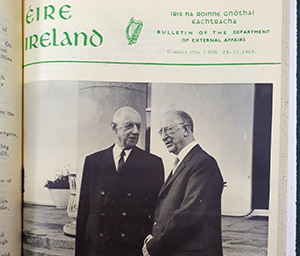De Gaulle in Ireland, 1969
Published in Issue 4 (July/August 2019), News, Volume 27When France’s ‘Long Fella’ found his roots.
By Sylvie Kleinman
On 18 June 1969, 29 years after his 1940 call from London appealing to Frenchmen to refuse defeat and resist the enemy, General Charles de Gaulle for once was not at the Mont Valérien outside Paris, France’s supreme site of commemoration of the dead of the Second World War. With his wife Yvonne and his loyal aide-de-camp, Vice-Admiral François Flohic, he was visiting the National Museum of Ireland on the penultimate day of their ‘secret’ break in Ireland. Much has been written about this Irish exile, nearly the last chapter of his life. Flohic, who had ‘done’ D-Day at 23, choose an iconic image for the cover of his memoirs, De Gaulle intime (2010): the trio advance in a leisurely fashion along a sandy beach, the sea gently splashing onto noble rocks leading up towards the promise of fragrant moss and endless greenery. The iconic image is instantly recognisable in the French collective imagination as Ireland. Pierre Joannon has eloquently described France’s Liberator, pacing King Lear-like in long strides in the bleak but ultimately comforting landscape, and evidently compared him to Dev, who invited him to the Áras. For in Ireland de Gaulle found what he had been looking for, relative peace and privacy. In the history of Franco-Irish relations, for once Ireland had seriously mattered. And Bord Fáilte in Paris went into overdrive.

Above: General Charles de Gaulle and President Éamon de Valera outside Áras an Uachtaráin, as depicted on the cover of Éire Ireland, the bulletin of the Department of External Affairs, 24 June 1969. (Department of Foreign Affairs and Trade)
Why la verte Erin? Since childhood de Gaulle had been steeped in his Irish roots. His maternal grandmother was descended from Anthony McCartan of Kinelarty, Co. Down, one of the Wild Geese and a captain in Berwick’s regiment in France, whose son had settled in Lille, de Gaulle’s own birthplace. The General did meet some McCartans, but specified that it could only be south of the border. His paternal grandmother, however, Joséphine-Marie, a prolific writer, had published Le libérateur de l’Irlande, ou vie de Daniel O’Connell in 1848, and (prophetically) it is said to have been one of little Charles’s earliest reads. The National Library of Ireland holds what appears to be the only surviving first edition. There was of course a visit to Derrynane. In Sneem, ‘Tante Yvonne’, as she was affectionately known by French journalists, had even met her locally born and Belgian-educated French governess, Mai McCarthy.
De Gaulle had resigned on 27 April 1969 after a decade as France’s president, when voters had rejected regionalisation and senate reform but really de Gaulle himself. After a brisk communiqué, clearly a farewell without an au revoir, he left the Élysée Palace and disappeared from public view, resurfacing probably where the French least expected him to be, stretching his very long legs on a Kerry beach. He wanted to be physically removed from the presidential campaign that he had triggered, yet the visit could never have been a complete secret. The French government jet needed to touch down (10 May) at Cork airport, the personal security of this eminent guest needed to be seen to, and he also had a rare blood group, as the ever-watchful Flohic reminisced. With the French Embassy and the Department of External Relations, as it then was, he devised stays in Kerry and Connemara, before ending up in Dublin (at the Áras). Secluded and astonishingly modest accommodation was ‘arranged’, and rumours circulated around Sneem that it could only be the pope. According to one of the innumerable anecdotes to emerge, they even dislodged Robert Mitchum, or rather David Lean’s film crew, from the set of Ryan’s daughter (1970) in the Dairy Cottage on the Kenmare Estate.
Without the near-instant benefits of social media, journalists quickly swooped down on their prey, as here was a story worth tripping in sand-dunes over. Flohic describes them as like bees from a scattered swarm, disturbing carefully charted outings (Bantry, bien sûr), but also how the chambermaids, invited by de Gaulle to private Mass, had trouble kneeling without falling over on the morning after the night before, when hospitality at the local inn had flowed. By 19 May the government had received an enquiry about acquiring the 2.13m-long bed specially delivered for the French ‘Long Fella’. Flohic warded off interviewers, but careful scrutiny of a French video clip (www.ina.fr/video/CAF89046472) reveals that they could not avoid almost getting stuck in a muddy boreen. In Dublin, the (just re-elected) Taoiseach Jack Lynch hosted a luncheon in Dublin Castle, where de Gaulle admired five silk replica flags of the Irish brigades, a gift from France in 1959, before toasting ‘L’Irlande toute entière’. Revisiting the episode reveals many a comic anecdote and a bygone age, e.g. of overt Catholicism and travellers’ currency restrictions. And speaking of Europe, France was then a major counterweight to Britain’s influence, having even blocked the UK’s entry into the Common Market. Numerous articles and photo collections have covered the story, and a plaque in Sneem recalls de Gaulle’s warm words to Dev, thanking Ireland for the chance it gave him to face himself and his long life.
Sylvie Kleinman is Visiting Research Fellow at the Department of History, Trinity College, Dublin.
FURTHER READING
P. Joannon (ed.), De Gaulle and Ireland (Dublin, 1991).
G. Neville, ‘“Guest of the Nation”: Charles de Gaulle’s visit to Ireland in the Irish press (1969)’, in J. Conroy (ed.), Franco-Irish connections: essays, memoirs and poems in honour of Pierre Joannon (Dublin, 2009).
















